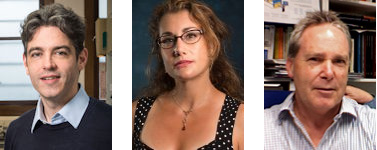From prebiotic chemistry to molecular evolution

Editors:
Prof. Leroy Cronin, University of Glasgow
Prof. Amanda C. Evans, California State University Fullerton
Prof. David A. Winkler, Commonwealth Scientific and Industrial Research Organisation
Prof. Leroy Cronin, University of Glasgow
Prof. Amanda C. Evans, California State University Fullerton
Prof. David A. Winkler, Commonwealth Scientific and Industrial Research Organisation
Relatively soon after the formation of the earth from a maelstrom of gas and dust, terrestrial inorganic chemistry started. Rocks, the first minerals, materials and salts formed, but how did the transition from inorganic chemistry to biology occur? The process of complexification is a mystery; was it Darwinian? was it combinatorial? what were the first organic precursors that started the journey to the formation of the first cells? In the absence of biological machinery, only simple molecules appear to be available, but many argue about prebiotic plausibility. These precursors were probably subjected to intense energy sources such as UV radiation, radioactivity and thermal energy, and these seemed to generate the necessary building blocks that eventually lead to life. But how did the process begin? Undoubtedly networks of chemical and physical interactions produced not only one soup, but many soups resulting in the formation of the biologically relevant sugars, amino acids, purines, pyrimidines, nucleotides, fatty acids and polymers thereof. But were these compounds formed by ‘dead’ systems, or byproducts from simple life forms? Can we be certain that the tight interlocking of these components led to metabolic processes we would recognize today, and that each of these generated new environments with different chemical compositions from that of the primordial earth? The result was the creation of spatially separated chemical systems, sequestered from, and shaping the environment, that were capable of energy transformation, maintaining a structure, and allowing the transmission of hereditary memory: the cell. Although there is common consensus that modern cells descended from a single common ancestor, how the complex machinery arose in that very first cell remains a total mystery.
Adsorption of RNA on mineral surfaces and mineral precipitates
- Elisa Biondi,
- Yoshihiro Furukawa,
- Jun Kawai and
- Steven A. Benner
Beilstein J. Org. Chem. 2017, 13, 393–404, doi:10.3762/bjoc.13.42

Conjecture and hypothesis: The importance of reality checks
- David Deamer
Beilstein J. Org. Chem. 2017, 13, 620–624, doi:10.3762/bjoc.13.60

How and why kinetics, thermodynamics, and chemistry induce the logic of biological evolution
- Addy Pross and
- Robert Pascal
Beilstein J. Org. Chem. 2017, 13, 665–674, doi:10.3762/bjoc.13.66

G-Protein coupled receptors: answers from simulations
- Timothy Clark
Beilstein J. Org. Chem. 2017, 13, 1071–1078, doi:10.3762/bjoc.13.106

From chemical metabolism to life: the origin of the genetic coding process
- Antoine Danchin
Beilstein J. Org. Chem. 2017, 13, 1119–1135, doi:10.3762/bjoc.13.111

Towards open-ended evolution in self-replicating molecular systems
- Herman Duim and
- Sijbren Otto
Beilstein J. Org. Chem. 2017, 13, 1189–1203, doi:10.3762/bjoc.13.118

Biomimetic molecular design tools that learn, evolve, and adapt
- David A Winkler
Beilstein J. Org. Chem. 2017, 13, 1288–1302, doi:10.3762/bjoc.13.125

Framing major prebiotic transitions as stages of protocell development: three challenges for origins-of-life research
- Ben Shirt-Ediss,
- Sara Murillo-Sánchez and
- Kepa Ruiz-Mirazo
Beilstein J. Org. Chem. 2017, 13, 1388–1395, doi:10.3762/bjoc.13.135

Grip on complexity in chemical reaction networks
- Albert S. Y. Wong and
- Wilhelm T. S. Huck
Beilstein J. Org. Chem. 2017, 13, 1486–1497, doi:10.3762/bjoc.13.147

Chemical systems, chemical contiguity and the emergence of life
- Terrence P. Kee and
- Pierre-Alain Monnard
Beilstein J. Org. Chem. 2017, 13, 1551–1563, doi:10.3762/bjoc.13.155

A recursive microfluidic platform to explore the emergence of chemical evolution
- David Doran,
- Marc Rodriguez-Garcia,
- Rebecca Turk-MacLeod,
- Geoffrey J. T. Cooper and
- Leroy Cronin
Beilstein J. Org. Chem. 2017, 13, 1702–1709, doi:10.3762/bjoc.13.164















































































